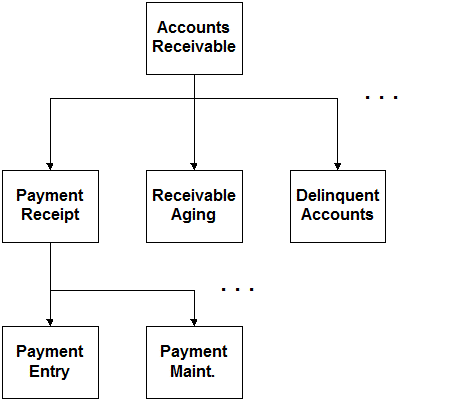After the high level requirements (HLRs) are identified, the intermediate level requirements (ILRs) should be estimated. There are three steps to identifying and estimating the number of ILRs within each HLRs:
Count the Known ILRs
After the HLRs are identified, each of the HLRs are broken down into intermediate level requirements (ILRs), which often correspond to screens, reports, transactions, etc. As much as possible, all appropriate team members, i.e., the user, the analyst, and/or the designer, should participate in the counting and identification of the ILRs. To complete the count for an individual HLR, the decomposition process is continued until there are no more intermediate level requirements for the HLR. This process is illustrated in Figure 8.

Intermediate Requirements Decomposition
Figure 8
Note that when counting, only the lowest level ILRs are counted. If an ILR is broken down further (i.e., in Figure 8 Payment Receipt is further broken down into Payment Entry and Payment Maintenance), count only the lowest level ILRs. If an ILR is not broken down further, then it counts as one. Therefore, in Figure 8 there are four lowest level ILRs identified: Payment Entry, Payment Maintenance, Receivable Aging, and Delinquent Accounts.
Estimate the Percentage Identified
The number of lowest level ILRs identified to-date is then used to estimate the total ILRs for an HLR. Estimating the level to which the requirements are clearly defined helps to account for the undefined or poorly defined requirements. This estimate is expressed as a percentage which falls into a classification range. For example, a percent estimate in the range of 80-100% may indicate that the requirements are very well defined, while a 0-50% estimate may indicate that requirements are poorly defined. It is important to document the basis for the estimated figures to provide a better understanding of the estimate and allow for adjustments in later phases of the project. The Requirements Sizing Matrix is used to summarize the estimates.
Project the Total Number
Once the percentage of known ILRs for each HLR has been estimated, the total is projected by dividing the number identified to-date by the estimated percentage of ILRs identified. This should then be recorded on the Requirements Sizing Matrix.